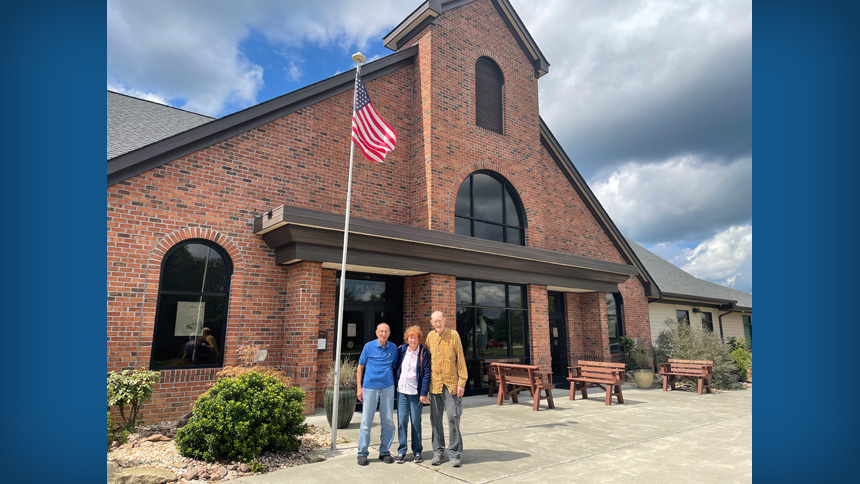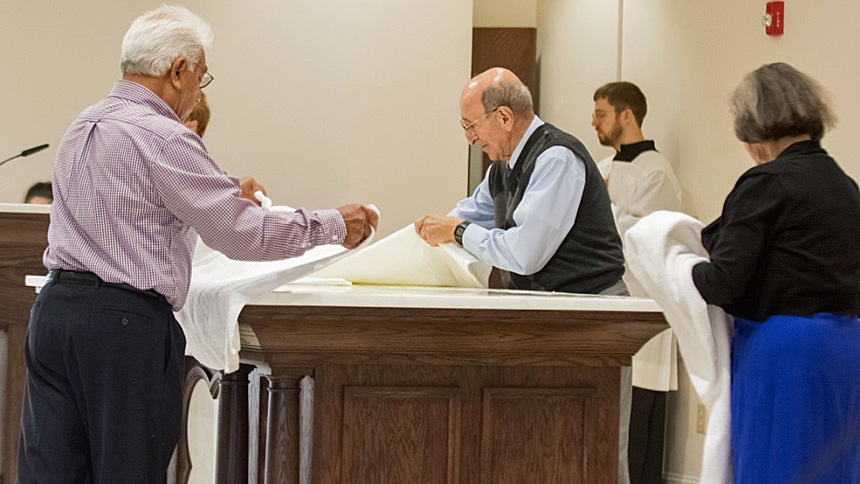
The Catholic community in Louisburg had its humble beginnings in the living room of the Rabil family home, where Mass was often celebrated by itinerant missionaries. Originally from Lebanon, the Rabils moved to the area in 1939.
In those early days, about two or three families would gather along with some students from Louisburg College. The congregation, by most accounts, grew steadily to 25 or 30 families in the years after WWII.
Today Ed Rabil is a parishioner at the parish his family helped begin. He can tell stories of those early days. And he’s not the only one - Eileen Robertson and Dan Connors also paint a very colorful story of the gypsy-like beginnings of the parish.
“The Roaming Catholics,” as Robertson fondly referred to the early members of OLOR, moved from the Rabil house to a variety of locations. These included a trailer, college chapel, elementary school and a dance studio. Eventually, though, the parish found a more permanent home on North Main Street.
Connors proudly spoke of his family’s involvement in the parish over these years. In the 1990s he assisted with altar server training and his wife Paula cared for the cleaning of the chapel and washing of the linens. Paula died in 2009; their daughter still lives in the area and their tradition of altar servers is continued by her children.
In August of 1999, Bishop F. Joseph Gossman appointed Sister Betty Bullen, I.H.M. as the pastoral administrator. She set about finding a name for their congregation and with communal help, Our Lady of the Rosary was born. Under her guidance and through the assistance of St. Catherine of Siena Parish, the community purchased and cared for the North Main Street property, which is still owned by Our Lady of the Rosary.
In time, the number of parishioners outgrew those premises especially when growth in Franklin County saw an increase in the Hispanic and Filipino communities, many of whom were Catholic.
In 2008, the Diocese of Raleigh, through The Land Trust program, purchased twenty acres on Highway 39, north of Louisburg. A grant was obtained through the Home Mission Society which provided some of the funding for construction of the church. Through donations from other generous benefactors, and some dedicated community fundraising, their efforts provided the remaining funds required to construct and furnish the church.
Ongoing fundraising efforts are continued today, spearheaded by the twice-yearly garage sale which draws crowds from the greater Franklin County community. Rabil, Robertson and Connors agree that this is a perfect way to promote the Catholic Church, evangelically.
Meanwhile, fundraising efforts enable the parish finance council to work toward the ongoing expansion of the parish center and possible purchase of more land surrounding the church.
Our Lady of the Rosary, a timeline
1939 The Rabil family home in Franklin County serves as a site for Catholic Mass, often celebrated by Missionary priests.
1940 St. Catherine of Siena Church and rectory are dedicated in Wake Forest. This marks the end of Sunday Mass in nearby Louisburg, and requires the faithful to travel to Wake Forest or Henderson for Mass. Families in the area reach out to Catholic students attending Louisburg College, and provide them with transport to Sunday Mass.
1966 Mass is celebrated at Louisburg College by priests of St. Catherine of Siena.
1999 Bishop F. Joseph Gossman appoints Sister Elizabeth Bullen, I.H.M. as pastoral administrator of the Catholic community in Louisburg. Around this time, the name “Our Lady of the Rosary” is chosen. Mass is celebrated in a rented school cafeteria.
2007 A former dance studio was rented for the celebration of Mass.
2011 Members of the Missionhurst Congregation (C.I.C.M.) are welcomed to Our Lady of the Rosary by Bishop Michael Burbidge. They continue to grow the community and develop the church to almost 300 families.
Father Johanes Raharjo, C.I.C.M., based at St. Eugene in Wendell, is the pastoral administrator, and Father Ryan Carnecer, C.I.C.M. becomes the resident vicar general.
With financial support from the parish community, The Land Trust, Home Mission Society and volunteer labor, the church was built.
December 19, 2015 Our Lady of the Rosary Roman Catholic Church is dedicated.
Information courtesy of Deacon Patrick McIlmoyle and Our Lady of the Rosary Parish, Louisburg. Read more of the story of Our Lady of the Rosary Parish at www.catholicolr.org.
What is the Home Mission Society?
The Home Mission Society is a diocesan, grant-based program to assist small and or rural parishes with the construction and furnishing of churches within the Diocese of Raleigh. Special emphasis is placed on building churches and chapels in areas where parishes need assistance to fund the construction of sacred worship space.
What is the Land Trust?
The Land Trust was established in the late 1980s. An infusion of capital, from the sale of land to N.C. State, allowed the diocese to purchase parcels of land to establish new parishes. This foresight was fundamental in the expansion of the diocese in conjunction with the rapid growth in the Triangle area and beyond.
To learn more about these programs and how you can help, please visit foundationdor.org and select Home Mission or email The Foundation’s director of development, Donna Aschraft, at Donna@foundationDOR.org. You may also call The Foundation on 919-568-1065.


